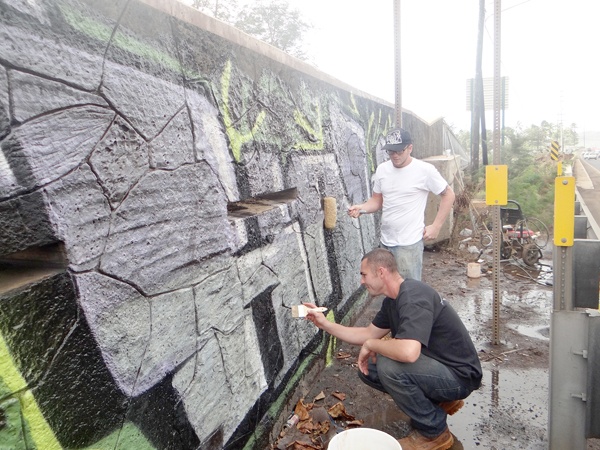WAILUA — Some people said it was art. Some people said it covered up art. Now, it’s gone. The graffiti on the inside of the Lihu‘e-bound Wailua River Bridge, the southbound structure of Mayor Bryan J. Baptiste Memorial Bridge Complex,
WAILUA — Some people said it was art. Some people said it covered up art. Now, it’s gone.
The graffiti on the inside of the Lihu‘e-bound Wailua River Bridge, the southbound structure of Mayor Bryan J. Baptiste Memorial Bridge Complex, was removed Wednesday, but the suspect who “tagged” the spot has yet to be found.
Commuters driving on the southbound lane early Wednesday morning saw Keith Duffy and Brandon Williams of Spencer’s Masonry working on the graffiti. The two said that some people were yelling and honking their horns at them thinking that they were painting the graffiti on the bridge.
They have been called out about three times previously to remove graffiti from the ocean-side and underneath the bridge. The perpetrators are much less noticeable on that side, they said.
This particular work is large and was painted overnight apparently without notice.
Both Duffy and Williams worked on the bridge project and pointed out that the graffiti was covering artistic concrete bridge art.
“Some people think graffiti is art, but not right here, and not this bridge,” Duffy said.
Until recently, the roadway and bridge graffiti problem was so small that the Hawai‘i Department of Transportation sent its own road crews to handle the problem, according to Caroline Sluyter, an HDOT public information officer.
“This really hasn’t been an issue,” Sluyter said. “This is the first big one we’ve had to deal (with). Up until now it has been super minor.”
“We did all that road work out there and it is a shame that somebody ‘graffitied’ it,” said Jordan Berg, owner of Spencer’s Masonry.
Spencer’s had to be called in because of the specialized vertical stamp project work on the bridge. HDOT wanted to make sure that the chemicals used to remove the graffiti did not damage the decorative surface.
Vertical stamp is essentially a concrete mix that works like a plaster and allows contractors to create specialty formations on wood, stone and concrete surfaces. According to Berg, the rules for bridge art is not to have protrusion above one-half inch.
The reason for the vertical stamp is, ironically, to not provide a flat surface on a bridge for graffiti artists.
The prevention effort didn’t work well in this case, Berg said, but the heavy sealer they used after construction helped to bring the paint right off with minimal effort.
Berg said that after trying every kind of stripping agent, it was a soy gel that worked best.
It also happens to be the most environmentally-friendly compound around, he added.
“We want to bring our work back to normal,” Berg said. “It does pull us off our other jobs to remedy this right now though.”
County Prosecuting Attorney Justin Kollar said graffiti is a form of criminal property damage and the level of the charge depends in part on the cost to repair and restore the site to normal.
“To me it is disrespectful for somebody to do that because it costs all of us money now to go out there and clean that up, just because this person thought it was important for us to see their name on a bridge,” Kollar said.
The Wailua Bridge is an example of someone who put a lot of time and energy into defacing a structure, but Kollar said there is no way of knowing if it is gang-related until the suspect is apprehended.
He is also concerned that the suspect put themselves in danger by going out into the middle of a busy highway just to mark territory or make sure his or her name is visible.
• Tom LaVenture, staff writer, can be reached at 245-3681 (ext. 224) or tlaventure@thegardenisland.com.


